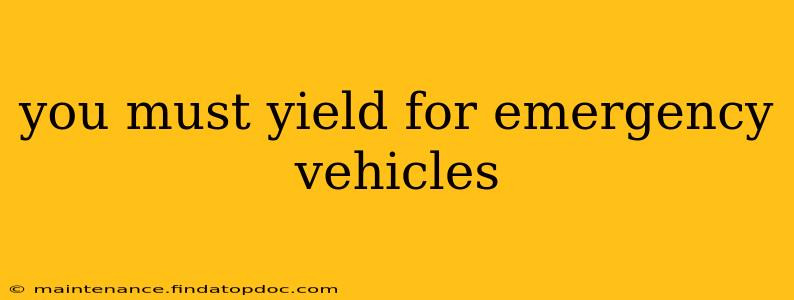Emergency vehicles—ambulances, fire trucks, police cars—save lives. Their urgent missions demand our immediate attention and cooperation. Knowing when and how to yield is not just a matter of courtesy; it's a legal requirement that can save lives. This guide details the importance of yielding, the laws surrounding it, and how to do so safely.
What Does "Yield" Mean When an Emergency Vehicle Is Approaching?
"Yield" means to give the right-of-way. When an emergency vehicle approaches with its lights and siren activated, you must immediately and safely pull over to the nearest edge of the roadway and stop. This allows the emergency vehicle to pass without obstruction, ensuring they reach their destination quickly and safely. Failure to do so can result in significant fines and, more importantly, contribute to tragic delays in emergency response.
What are the Laws Regarding Yielding to Emergency Vehicles?
Laws regarding yielding to emergency vehicles vary slightly by state and jurisdiction, but the core principle remains consistent: you must yield the right-of-way. Specifics might include:
- Signal Activation: The emergency vehicle must have its lights and siren activated for the yielding requirement to be in effect.
- Location of Yielding: Generally, you should pull over to the right-hand side of the road, but circumstances might necessitate pulling to the left, particularly on one-way streets or divided highways.
- Safe Stopping: You must stop in a safe location, avoiding obstructing traffic or creating a hazard.
- Penalties for Non-Compliance: Penalties for failing to yield can range from fines to suspension of driving privileges.
How to Safely Yield to Emergency Vehicles
Yielding safely is paramount. Here’s a step-by-step guide:
- Hear and See: Listen for sirens and watch for flashing lights.
- Pull Over: Move to the nearest edge of the roadway. Be aware of other vehicles and avoid sudden stops.
- Stop Safely: Ensure you are parked safely and not obstructing traffic.
- Wait: Remain stopped until the emergency vehicle has passed.
- Proceed Carefully: After the emergency vehicle has passed, carefully re-enter traffic, checking for other vehicles before doing so.
What if I'm on a Multi-Lane Road?
On a multi-lane road, pull over to the rightmost lane if possible. If this isn’t safe due to traffic or other obstructions, you may pull over to the left lane, or any lane that provides the safest and quickest method of clearing the way for the emergency vehicle. Always exercise caution and prioritize safety.
What if I'm on a Highway?
On a highway, pull over to the right shoulder or emergency lane. Never stop in the traffic lanes. Check your mirrors and make sure it is safe to move over before doing so.
What are the Consequences of Not Yielding to Emergency Vehicles?
The consequences of failing to yield to emergency vehicles are severe and extend beyond simple fines. You could face:
- Fines: Substantial fines are common across jurisdictions.
- License Suspension: In some cases, license suspension or revocation might result.
- Legal Liability: If your failure to yield causes an accident or delays emergency response, you could face legal liability.
- Moral Responsibility: More importantly, you could be contributing to a delay in critical emergency services, potentially impacting someone's life or safety.
Conclusion
Yielding to emergency vehicles is a critical aspect of safe and responsible driving. Understanding the laws and knowing how to safely yield not only protects you but also helps ensure those in need receive timely emergency assistance. Prioritize safety, be vigilant, and always yield to emergency vehicles when they have their lights and sirens activated.
